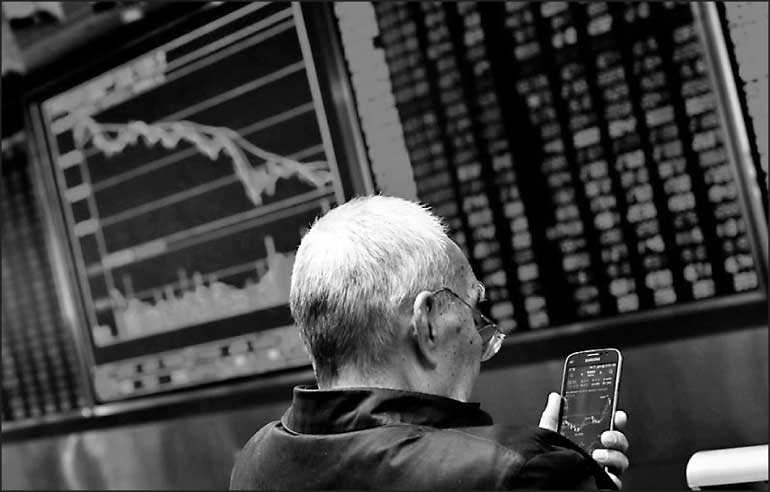Wednesday Mar 12, 2025
Wednesday Mar 12, 2025
Saturday, 22 December 2018 00:00 - - {{hitsCtrl.values.hits}}

An investor sits in front of a board showing stock information at a brokerage office in Beijing, China - REUTERS
SYDNEY (Reuters): Global stocks were sinking in a sea of red on Friday as the threat of a US government shutdown and of further hikes in US borrowing costs sent dismayed investors sailing for safer harbours.
The S&P 500 was heading for its worst quarter since the dark days of late 2008, with a loss of 15 percent so far. The Nasdaq has shed 19.5 percent from its August peak, just shy of confirming a bear market.
Oil prices slid just over 4 percent overnight, bringing Brent’s losses since its October top to 37 percent. The dollar had suffered its biggest one-day drop on the yen since November 2017 as investors stampeded to safe havens.
Michael McCarthy, chief market strategist at CMC Markets, said the downward spiral was becoming self fulfilling with selling begetting more selling.
“Negative momentum is a key factor in driving investor behaviour. Fundamental justifications are following the action,” said McCarthy. “The selling will finish when it is done.”
E-Mini futures for the S&P 500 were off another 0.3 percent, while spread betters pointed to a soft start for the major European bourses. MSCI’s broadest index of Asia-Pacific shares outside Japan shed 0.5 percent.
Japan’s Nikkei fell 1.5 percent, and was down more than 6 percent for the week so far, while Australian stocks slipped 1.3 percent to a two-year trough.
Chinese blue chips lost 1.6 percent, in part after the United States accused Beijing of orchestrating the hacking of government agencies and companies around the world.
Sentiment had turned sour on Thursday when the US Federal Reserve largely retained plans to increase interest rates despite mounting risks to growth.
Markets were further spooked when US President Donald Trump refused to sign legislation to fund the US government unless he got money for a border wall, thus risking a partial federal shutdown on Saturday.
“Political brinkmanship in Washington is further heightening market uncertainty,” said Westpac economist Elliot Clarke.
“Friday will be a tense day in Washington, and for financial markets, as a last-minute compromise is sought.”
Adding to the air of crisis was news US Defense Secretary Jim Mattis had resigned after Trump proposed withdrawing troops from Syria and sources said a military pullback from Afghanistan was on the cards.
The brittle mood showed on Wall Street where the Dow ended Thursday with a loss of 1.99 percent. The S&P 500 dived 1.58 percent and the Nasdaq 1.63 percent.
The mood change has triggered a rush out of crowded trades, including massive long positions in US equities and the dollar and short positions in Treasuries.
Lipper data on Thursday showed investors pulled nearly $34.6 billion out of stock funds in the latest week and were heading for the biggest month of net withdrawals on record.
There was also a sense of capitulation in currency markets as the dollar dived 1.1 percent on the yen on Thursday to hit a three-month trough at 110.80. It was last changing hands at 111.38 having shattered several layers of chart support.
The euro stood at $1.1444, having jumped to its highest in over six weeks at $1.1485. Against a basket of currencies, the dollar stood at 96.457 after suffering its largest single-session fall in two months.
The flight from risk was a boon to sovereign bonds, where US 10-year yields struck their lowest since early April at 2.748 percent. As recently as October, they had been at a seven-year top of 3.261 percent.
The gap between two- and 10-year yields shrank to just 9 basis points at one stage, the kind of flattening that has heralded recessions in the past.
The rally in longer-dated bonds has been fuelled by the huge slide in oil prices, which will pile downward pressure on inflation at a time when the global economy is already slowing.
Both Brent and US crude futures reached their lowest in more than a year overnight, but edged higher on Friday on talk production cuts by OPEC might be larger than first thought.
US crude eked out a 38 cent bounce to $46.26 a barrel, while Brent rose 31 cents to $54.66.
Gold was underpinned by the reversal in the dollar to hold at $1,259.29 an ounce.
Discover Kapruka, the leading online shopping platform in Sri Lanka, where you can conveniently send Gifts and Flowers to your loved ones for any event including Valentine ’s Day. Explore a wide range of popular Shopping Categories on Kapruka, including Toys, Groceries, Electronics, Birthday Cakes, Fruits, Chocolates, Flower Bouquets, Clothing, Watches, Lingerie, Gift Sets and Jewellery. Also if you’re interested in selling with Kapruka, Partner Central by Kapruka is the best solution to start with. Moreover, through Kapruka Global Shop, you can also enjoy the convenience of purchasing products from renowned platforms like Amazon and eBay and have them delivered to Sri Lanka.
Discover Kapruka, the leading online shopping platform in Sri Lanka, where you can conveniently send Gifts and Flowers to your loved ones for any event including Valentine ’s Day. Explore a wide range of popular Shopping Categories on Kapruka, including Toys, Groceries, Electronics, Birthday Cakes, Fruits, Chocolates, Flower Bouquets, Clothing, Watches, Lingerie, Gift Sets and Jewellery. Also if you’re interested in selling with Kapruka, Partner Central by Kapruka is the best solution to start with. Moreover, through Kapruka Global Shop, you can also enjoy the convenience of purchasing products from renowned platforms like Amazon and eBay and have them delivered to Sri Lanka.